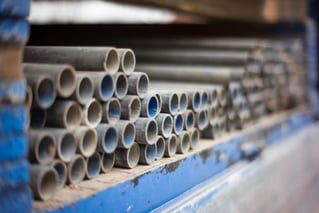Pipeline Projects Vary by Diameter Across the United States
Pipeline Inspection companies and their crews need to be flexible enough to handle various pipeline dimensions with new pipeline projects starting in the United States in 2021 ranging from 6 inches in diameter to 42 inches.
There was a time when inline inspections with intelligent pigs could only handle large dimension pipes but advancing technology now allows for pigging devices to handle cleaning and inspections of smaller diameter pipes, all the way down to 3 inches.
“The accuracy of location and measurement of anomalies by the intelligent pigs has continued to improve. Initially, the electronics and power systems were so large that intelligent pigs could be used only in lines 30 inches and greater in size,” says PetroWiki. “The continued sophistication and miniaturization of the electronic systems used in the intelligent pigs has allowed the development of smaller pigs that can be used in small-diameter pipelines.”
sophistication and miniaturization of the electronic systems used in the intelligent pigs has allowed the development of smaller pigs that can be used in small-diameter pipelines.”
At GeoCorr, for example, tethering MFL/GEO/IMU Inspection Technologies allows for inspections of pipelines typically considered “unpiggable” and allows for the assessment of pipelines ranging from 3 inches to 48 inches.
According to NaturalGas.org, the average diameter of an interstate pipeline is between 24 and 36 inches with an average of 30 inches.
History of Pipeline Sizes
The history of oil and gas pipeline sizes is a progression from the earliest days of crude 2-inch cast-iron pipe to 48-inch modern TransAlaska Pipeline.
Here is the timeline of pipeline diameters:
- 1860s the earliest pipelines were made of 2-inch cast-iron threaded and screwed together.
- 1870s Crude oil trunk lines were constructed in 18-foot sections of lap-welded wrought iron of 5 or 6-inch diameter.
- 1879 the first long-distance crude oil pipeline, 100 miles between Coryville and Williamsport, Penn., was made of 6-inch wrought-iron pipe laid above ground.
- Until the 1930s when large-diameter steel pipe was put into use, multiple 8-inch and 12-inch would be laid in the same right-of-way to increase delivery volume.
- 1942 and 1943 the U.S. government financed the building of “Big Inch” and “Little Big Inch” pipelines to move petroleum from Texas to New Jersey during World War II. Big Inch was a 24-inch pipeline running 1,254 miles and Little Big Inch was a 20-inch pipeline running 1,475 miles.
- Post World War II the shift was on to larger diameter pipelines with 69 such projects between 1946 and 1958. Between 1936 and 1950 the number of pipelines over 12 inches in diameter in the U.S. went from 80 to 4,811.
- 1960s saw the Colonial Pipeline built with diameters ranging between 32 and 36 inches for a line that ran from Houston to New York City. A 40-inch line was built from Louisiana to Illinois.
- The ultimate large diameter project, the 48-inch TransAlaska Pipeline was completed in 1977, running 800 miles from Prudhoe Bay to Valdez, Alaska.
Today’s Pipeline Projects Range from Small to Large
The U.S. Energy Information Agency tracks U.S. pipeline projects and its listing of completed pipelines in 2021 shows that pipes of all diameters are being used.
In fact, in its latest update, it shows 16 lines of 9 different diameters being finished in 2021.
Pipeline projects vary in diameter depending on what they are transporting:
- Pipeline projects that transport crude oil tend to be larger with diameters this year ranging from 16 inches to 42 inches.
- Pipeline projects that transport hydrocarbon gas liquid tend to be smaller with diameters this year ranging from 12 to 20 inches.
- Pipeline projects that transport refined products such as gasoline and diesel tend to be the smallest with diameters this year ranging from 6 to 8 inches.
Pipeline projects will often feature multiple pipeline diameters such as the Appalachia to Texas (ATEX) expansion on the books for 2022 with 1,205 miles of pipeline that is 14, 16, and 20-inch in diameter.
All told, pipelines coming online this year have diameters of: 6, 8, 12, 16, 20, 24, 30, 36 and 42 inches.
Future Pipeline Diameters for Projects
The North American Midstream Infrastructure through 2035 is a detailed report put out by the INGAA Foundation in 2018 that looks at, among other things, future pipeline projects and diameters that will be used.
Some of the key takeaways:
- Most pipeline capacity added in each of the scenarios is large pipe, averaging just over 26-inches in diameter.
- Some of the projects, particularly the oil projects transporting heavy crude oil from Western Canada into the U.S. and toward the Gulf Coast require very large pipes, each of which is upwards of 32-inches in diameter.
The reported projected average diameters for pipeline of different projects through 2035 including:
- Gathering and Processing: Gas 8.0 inches average; 0il 6.1 inches.
- Oil, Gas and Natural Gas Pipelines: Oil 27.6 inches; gas 29.2 inches; natural gas 18.3 inches.
- Oil product pipelines: 13.5 inches.
No matter what size your pipeline project, contact GeoCorr today to find out how we can provide you with MFL Technology, Caliper Technology, and Inertial Mapping Technology that can help protect your assets.


.jpg)